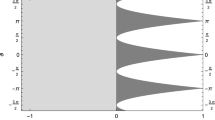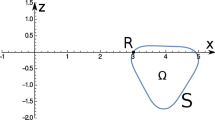Abstract
For a given discrete subgroup \(\Gamma =\alpha \mathbb Z\) of \((\mathbb C,+)\), we consider the Landau Hamiltonian acting on the space of \((L^2,\Gamma )\)-automorphic functions, perturbed by an electric potential with compact support on \(\mathbb C/\Gamma \). We investigate the asymptotic behaviour of the discrete spectrum near Landau levels.
Similar content being viewed by others
Data availability
Data sharing is not applicable to this article as no datasets were generated or analyzed during the current study.
References
Filonov, N., Pushnitski, A.: Spectral asymptotics of Pauli operators and orthogonal polynomials in complex domains. Commun. Math. Phys. 264(3), 759–772 (2006)
Intissar, A., Ziyat, M.: True Bargmann transforms for rank one automorphic functions associated with Landau levels. J. Math. Phys. 58(6), 063512 (2017)
Intissar, A., Ziyat, M.: On the Bochner Laplacian operator on theta line bundle over quasi-tori. Commun. Partial Differ. Equ. 45(10), 1319–1334 (2020)
Korotyaev, E., Pushnitski, A.: A trace formula and high-energy spectral asymptotics for the perturbed Landau Hamiltonian. J. Funct. Anal. 217(1), 221–248 (2004)
Melgaard, M., Rozenblum, G.: Eigenvalue asymptotics for weakly perturbed Dirac and Schrödinger operators with constant magnetic fields of full rank. Commun. Partial Differ. Equ. 28(3–4), 697–736 (2003)
Pushnitski, A., Rozenblum, G.: Eigenvalue clusters of the Landau Hamiltonian in the exterior of a compact domain. Doc. Math. 12, 569–586 (2007)
Pushnitski, A., Raikov, G., Villegas-Blas, C.: Asymptotic density of eigenvalue clusters for the perturbed Landau Hamiltonian. Commun. Math. Phys. 320, 425–453 (2013)
Raikov, G.D.: Eigenvalue asymptotics for the Schrödinger operator with homogeneous magnetic potential and decreasing electric potential. I. Behaviour near the essential spectrum tips. Commun. Partial Differ. Equ. 15(3), 407–434 (1990)
Raikov, G.D., Warzel, S.: Quasi-classical versus non-classical spectral asymptotics for magnetic Schrödinger operators with decreasing electric potentials. Rev. Math. Phys. 14(10), 1051–1072 (2002)
Acknowledgements
The authors would like to thank the anonymous referees for the helpful remarks and suggestions.
Author information
Authors and Affiliations
Corresponding author
Ethics declarations
Conflict of interest
The authors state that there is no conflict of interest.
Additional information
Publisher's Note
Springer Nature remains neutral with regard to jurisdictional claims in published maps and institutional affiliations.
Appendix A. Boundedness of \(\mathcal P_\Gamma \)
Appendix A. Boundedness of \(\mathcal P_\Gamma \)
Lemma A.1
Let \(\Gamma \) be a discrete subgroup of \((\mathbb C,+)\) (\(\Gamma =\alpha \mathbb Z\); \(\alpha \in \mathbb C\setminus \{0\}\) or \(\Gamma =\mathbb Z+\tau \mathbb Z\); \(\Im (\tau )>0\)). Then, the operator \(P_{\Gamma }\) is bounded from \(\mathcal E(q)\) to \(\mathcal E_\Gamma (q)\).
Proof
We begin by studying the operator \(\mathcal P_\Gamma \) on the Fock space \(\mathcal E(0)\). Recall the following well-known atomic decomposition for \(f\in \mathcal E(0)\)
We choose \(r_\gamma =|\gamma |^7+1\). Thus, for \(f\in \mathcal E(0)\), using the Cauchy–Schwarz inequality, we have
Applying again the Cauchy–Schwarz inequality, we get
Noting that the series \(\sum _{\gamma \in \Gamma } \frac{1}{r_\gamma ^{2/3}}\) converges in both cases \(\Gamma =\mathbb Z\) and \(\Gamma =\mathbb Z+\tau \mathbb Z\). We integrate over a fundamental domain, which can be chosen as \(\Lambda (\Gamma )=[0,1]\times \mathbb R\) if \(\Gamma =\mathbb Z\) and as \(\Lambda (\Gamma )=[0,1]\times [0,\Im (\tau )]\) if \(\Gamma =\mathbb Z+\tau \mathbb Z\). We get
Noting that we have \(\int _{\Lambda (\Gamma )}\chi _{D(w-\gamma ,r_\gamma )}(z)d A(z)\le 2r_\gamma ,\) we can conclude that
The series in the right-hand side converges in both cases, and hence, \(\mathcal P_\Gamma (f)\) is bounded on \(\mathcal E(0)\).
Now, since the \( L^2 \) convergence implies uniform convergence in a holomorphic setting, the boundedness of \(\mathcal P_\Gamma \) implies the uniform convergence of \(\mathcal P_\Gamma (f)(z)\) on every compact subset of the fundamental domain \( \Lambda (\Gamma ) \). To conclude, it suffices to notice that for every compact subset K of \( \mathbb C\), we can find a compact subset \( K_0 \subset \Lambda (\Gamma ) \) and a finite sequence \( \gamma _0,\cdots ,\gamma _n \) such that \( K \subset \bigcup \nolimits _{j=0}^{n} (K_0 + \gamma _j) \). Hence, \( \mathcal P_\Gamma (f)\) is a holomorphic function on \( \mathbb C\). Finally, it is clear that \(\mathcal P_\Gamma \) satisfies the functional equation, and hence, \(\mathcal P_\Gamma \) is a bounded operator from \(\mathcal E(0)\) into \(\mathcal E_\Gamma (0)\).
The space \(\mathcal E(q)\) (resp. \(\mathcal E_\Gamma (q)\)) is in connection with \(\mathcal E(0)\) (resp. \(\mathcal E_\Gamma (0)\)) via the annihilation and creation operators. Precisely, let \(A=\partial _{{\bar{z}}}\) be the annihilation operator. Its adjoint operator is \(A^*=\partial _{ z}-B{\bar{z}}\), the creation operator. In addition, let \(T_a\) be the Weil representation defined by
These operators satisfy the following equations:
Furthermore, the creation operator gives an isometry between \(\mathcal E(0)\) (resp. \(\mathcal E_\Gamma (0)\)) abd \(\mathcal E(q)\) (resp. \(\mathcal E_\Gamma (q)\)). Precisely, we have that
is an isometry from \(\mathcal E(0)\) to \(\mathcal E(q)\) (resp. from \(\mathcal E_\Gamma (0)\) to \(\mathcal E_\Gamma (q)\)). Using (A.1) as well as (A.2), we see that \(\mathcal P_\Gamma \) is a bounded operator from \(\mathcal E(q)\) to \(\mathcal E_\Gamma (q)\). This finishes the proof. \(\square \)
Rights and permissions
Springer Nature or its licensor (e.g. a society or other partner) holds exclusive rights to this article under a publishing agreement with the author(s) or other rightsholder(s); author self-archiving of the accepted manuscript version of this article is solely governed by the terms of such publishing agreement and applicable law.
About this article
Cite this article
Benahmadi, A., Ziyat, M. Spectral asymptotics for the Landau Hamiltonian on cylindrical surfaces. Lett Math Phys 113, 70 (2023). https://doi.org/10.1007/s11005-023-01695-7
Received:
Revised:
Accepted:
Published:
DOI: https://doi.org/10.1007/s11005-023-01695-7




